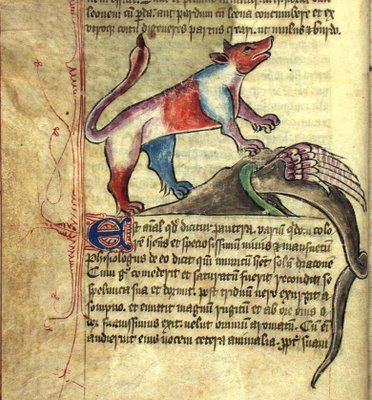
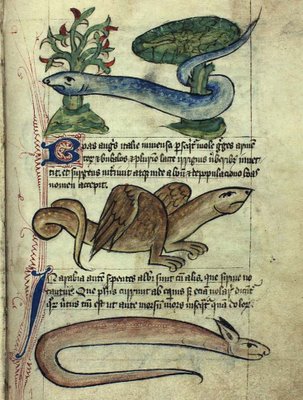
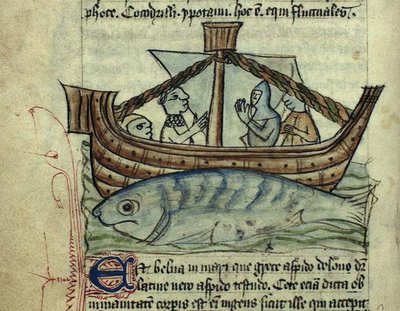
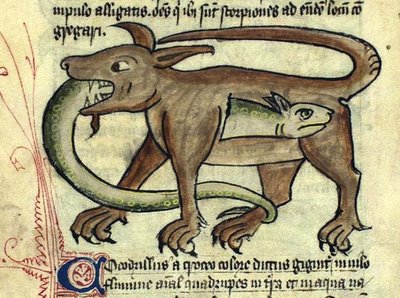
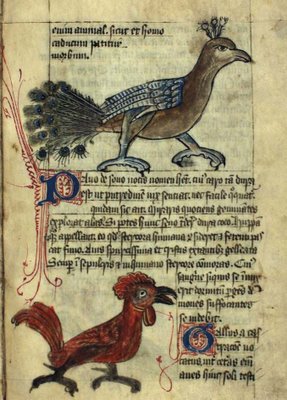
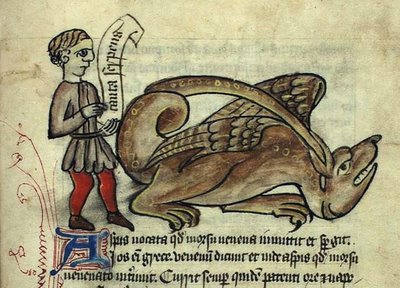
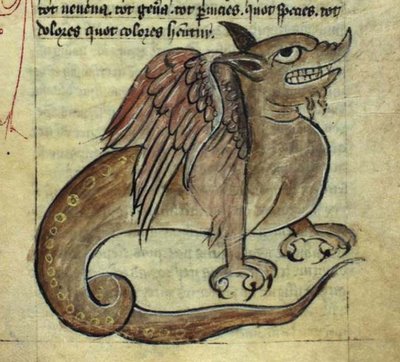
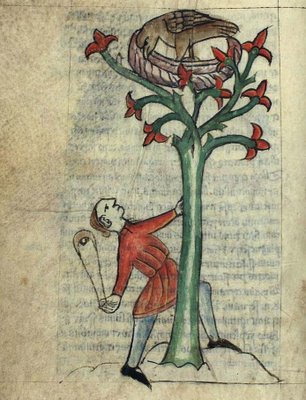
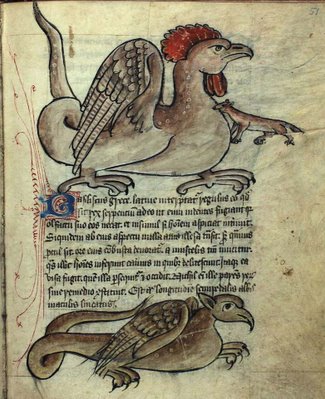
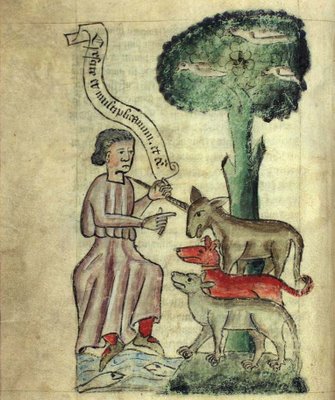
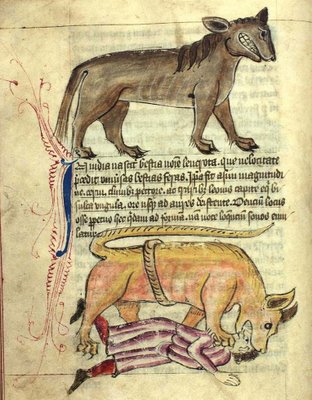
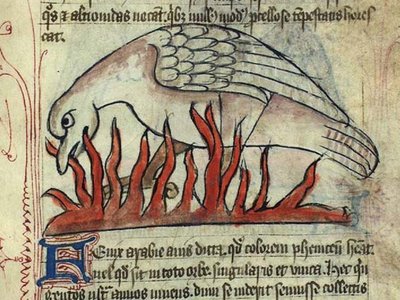
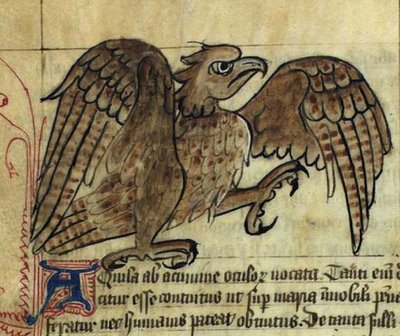
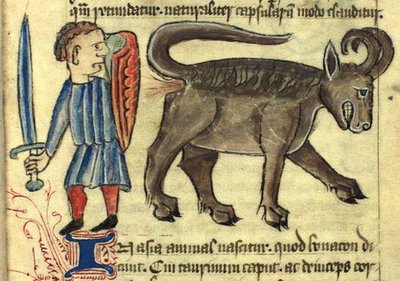
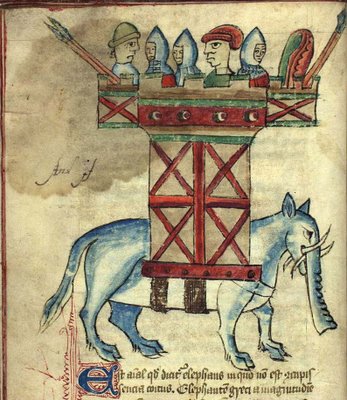
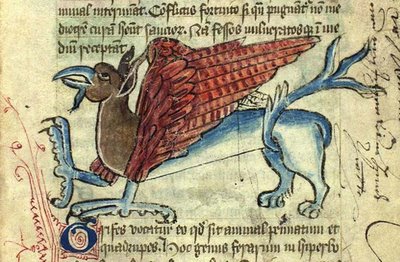
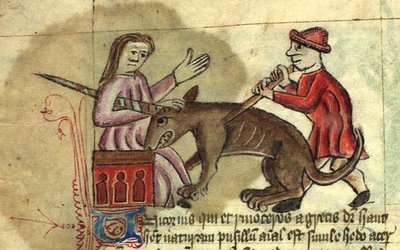
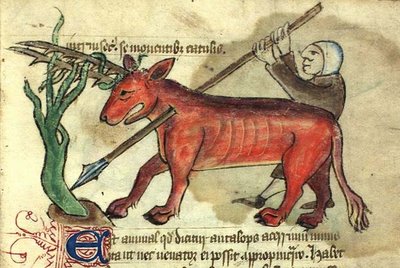
Bestiaries are part of a tradition that began in the 3rd or 4th centuries AD with the greek 'Physiologus', a collection of animal-based moral stories, widely circulated in Europe. Later, the illustrated texts were expanded and came to include not only the religious/moral elements, but also commentary drawn from other 'more scientific' sources such as Pliny the Elder and Aristotles. The artists were often copying from predecessors and were unlikely to have been familiar with many of the animals, accounting for the odd appearance at times. Fabulous animals such as mermaids, unicorns, griffins and dragons were usually included. These works from the 13th to 15th centuries were obviously the forerunners to the natural history books from the renaissance period and beyond.
The images above come from a parchment manuscript identified as 'GKS 1633 4º: Bestiarius' in the Danish Royal Library in Copenhagen. There are 117 illustrations in the 154 page book.
This is an english bestiary in a 'bastard anglicana' latin script from the beginning of the 15th century. It is otherwise known as The Bestiary of Anne Walshe because her name appears in crude practice writing in some of the margins; she was no doubt a young girl in England when she was given free reign over this book early in its life.
It is by no means a luxury production - the images are uncomplicated, no gold leaf was used and much of the pigment is in dull colour washes - but the artist shows a sense of humour and the illustrations mostly retain their original bright visual characteristics.
The Bestiary of Anne Walshe was the subject of a student paper by David Badke at the University of Victoria in Canada in 2001 which is available at The Medieval Bestiary site. The paper is well worth reading. It's not too complicated and it's interesting to read about the systematic way in which a medieval text is evaluated.
Thursday, November 30, 2006
Bestiarius
Wednesday, November 29, 2006
Mayan Civilization Bas Reliefs at Palenque
"It is by no means improbable that these fantastic forms, and others equally whimsical, were the delineations of some of their deities, to whom they paid an idolatrous worship, consistent with their false belief and barbarous customs."
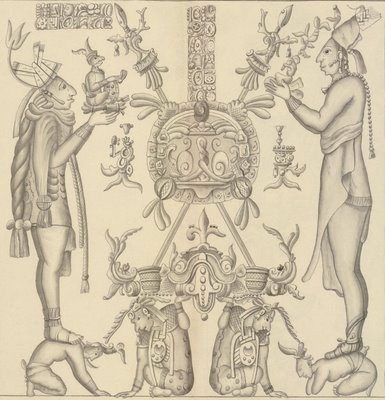

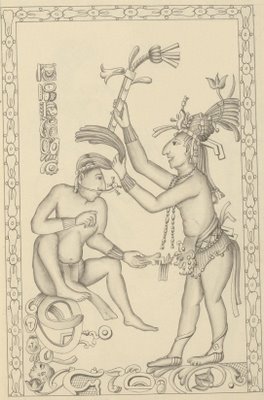

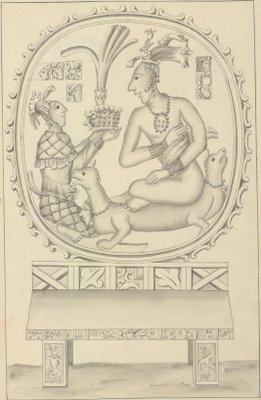

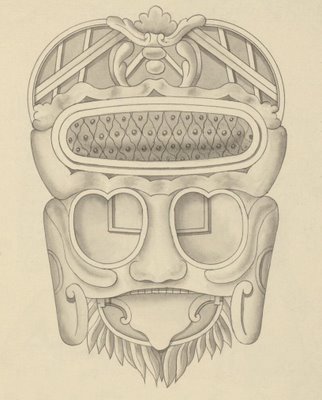
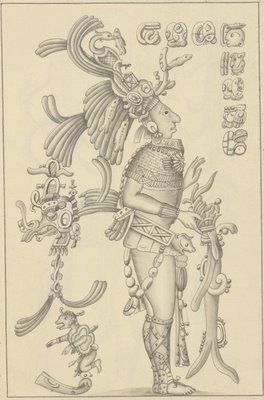


[click to enlarge]
Palenque, in the far southern Chiapas region of Mexico [map] (formerly part of Guatemala), was a significant city-state of the Mayan civilization. Although the site was already an important centre from around 400AD, the palace-topped pyramid and nearby temple structures [Mesoweb Palenque resources] weren't built until the 7th century. The buildings were mysteriously abandoned with the decline of the Mayan culture in the 9th century. [Theories as to the cause for this range from soil exhaustion to disease to invasion to natural disaster to trade route collapse to...]
The forest had overgrown Palenque by the time the first European visited in 1567. But little interest was shown in the site again until the 1770s when the military governor of Guatemala received a report which must have piqued his interest. He sent a party to investigate further in 1784, led by Colonel Antonio Del Rio and accompanied by the artist Ricardo Almendáriz. Despite the damage they caused to some buildings (and pillaging of relics to send to Spain), the team made a reasonably thorough survey of the site and Almendáriz was able to sketch 30 ink/ink wash drawings of the temple and palace bas reliefs to accompany the report of Del Rio.
From then on things get very confused - a number of different works were published during the next few decades and Del Rio's report apparently lay dormant for some reason. But the drawings themselves (the originals have only been discovered in private hands in the recent past) were published alone in Mexico in 1787 as: 'Coleccion de Estampas Copiadas de las Figuras Originales, que de Medio, y Baxo Relieve, Se Manifiestan, en Estucos y Piedras, en Varios Edificios de la Poblacion Antigua Nuevamente Descubierta en las Immediaciones del Pueblo Del Palenque', which is online in its entirety at the Library of Congress. {64 page book, no thumbnails, giant sizes available, illustration every 2nd page mostly} [The first european publication of a Palenque drawing was in a work by Humboldt in 1810, posted previously]
We must thank the devil for this. It was while searching for information about the demonologist Martin Del Rio the other day that I happened upon this exquisite series. I spent a lot of time cleaning up the background artifact in the images above, some of which are details. If there was a 'find of the month category', I think this book would be a pretty good bet for mine.
"There is no difficulty in publishing Tom Thumb -- or any thing else -- when we are disposed; and yet all America cannot furnish sufficient encouragement to publish a work on the greatest, yes, absolutely the greatest wonder in the world, discovered within her own borders! Well indeed should we deserve the scorpion lash of foreign Trollopes, if this were so."And with such admonishment, Dr. Pablo Felix Cabrera arranged to translate and publish the Del Rio document with third hand copies of the illustrations in London in 1822. The english text of Del Rio's report is published on this Oliver Cowdry website (it's not very long) together with a lot of Cabrera balderdash - he imagines a Phoenecian origin to the civilizations of America - but followed by a useful timeline with respect to the convoluted publishing/expedition history surrounding Palenque. Mormons figure prominently.
The Palenque Round Table Series in the Pre-Columbian Art Research Institute Journal .
Tuesday, November 28, 2006
Furttenbach Architectura
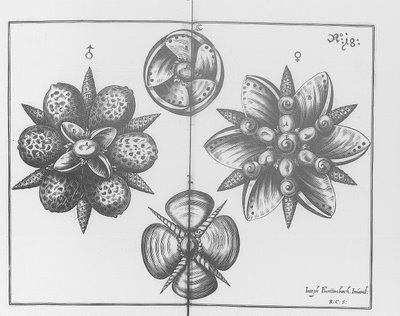
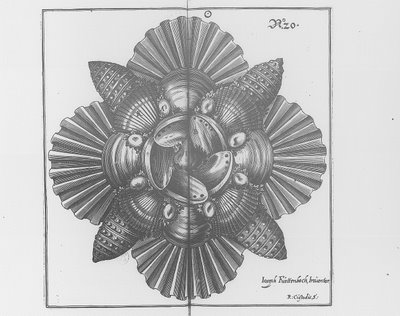
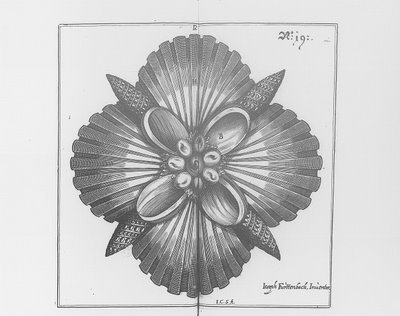
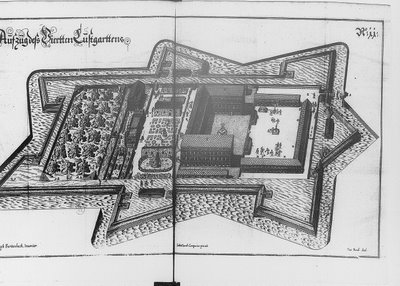
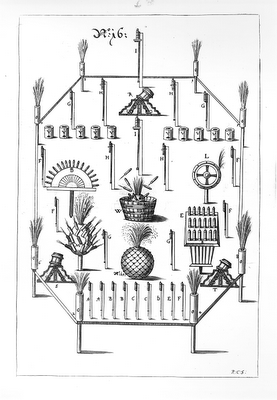







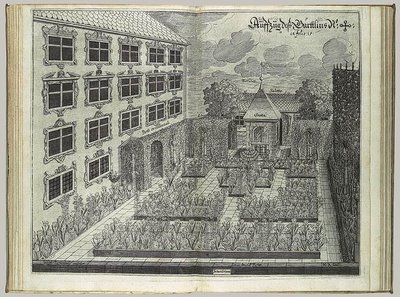
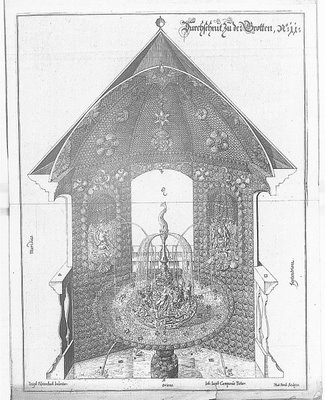

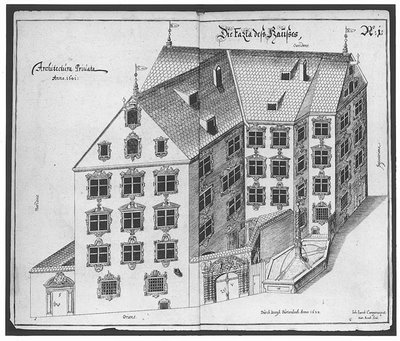
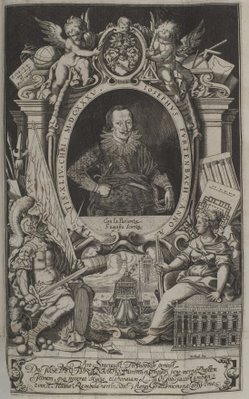
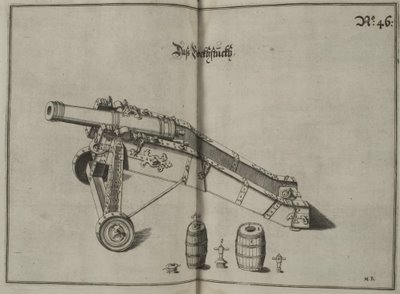


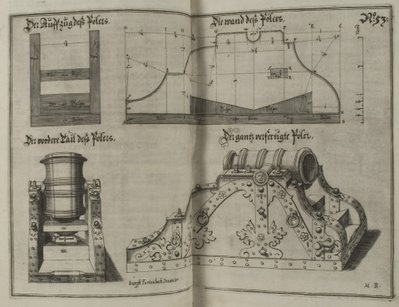
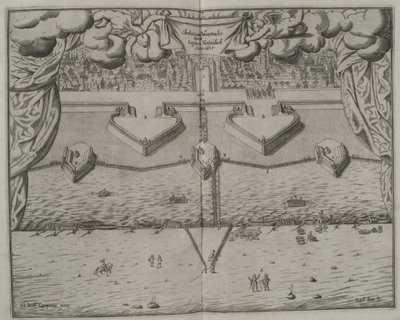
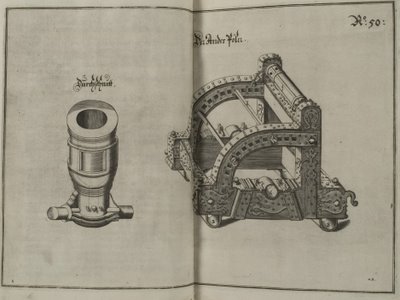
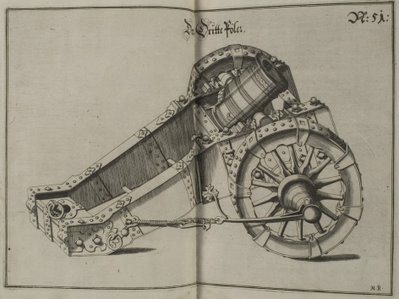
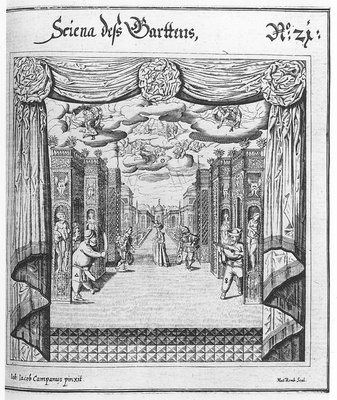
Although Joseph Furttenbach (1591-1667) spent the majority of his life in Ulm in southern Germany, it was a 10 year stay in Italy in his youth that informed his later professional output as an architect and author. He studied engineering, military architecture and stage design while in Tuscany and Florence and was influential in promoting design elements of the italian and french baroque schools in Germany.
Furrtenbach was something of a polymath and held various governmental positions in Ulm (including City Architect) where his interests included: cartography, chemistry (he described numerous gunpowder experiments he did himself in his pyrotechnics treatise), bridge, ship and organ building as well as elite home garden design.
"Furttenbach describes the grotto in his garden as being filled with artifice and exotica, including shell-encrusted sculptures and waterworks, painted cosmological imagery, and mirrors. His garden is a kind of open-air museum where the plants constitute the valued, living statues. The flowers are identifiable as the most sought after and costly bulbs of the period, the narcissus, tulip, fritillary, and crown imperial, demonstrating Furttenbach's knowledge of current botanical research."'Architectura Universalis' (the canon series of images above) remains his best remembered work - "[a] treatise on the engineering and building of fortifications, trenches, barracks, military schools, hospitals, lazarettos, bridges, moats, boats and boat-yards, guns, canons, and much more."
There have been various compilations of Furttenbach's works released and I'm reasonably confused as to which images (scattered across the internet) derive from which original book. To the best of my very limited understanding, his major works (all of which are represented above I believe) are:
--'Halintro-Pyrobolia'. 1627 (or: 'essays on guns, fireworks, sulfur, coal, and other substances used in the manufacture of explosives')
--'Architectura Civilis'. 1628
--'Architectura Martialis' 1629
--'Architectura Universalis'. 1635
--'Architectura Recreationis'. 1640 (stage and theatre design)
--'Architectura Privata' 1641
--'Mannhafter Kunst-Spiegel' 1663 (synthesis of previous architectural interests but combined with ideas about navigation, geography, astronomy and perspective)
- 'Architectura Universalis' at Heidelberg University (click on 'Titelblatt' then '-' at the bottom of the page for thumbnails: it's taken me a long time to work this trick out).
- 'Architectura Martialis' at BNF (engravings by Jacob Custodis)
- 'Architectura Civilis', 'Architectura Recreationis' at BNF (engravings by Raphaël Custodis)
- 'Architectura Privata' at BNF (engravings by Matthias Rembold)
- 'Architectura Civilis' at Heidelberg University (no illustrations)
- 'Halintro-Pyrobolia' (just 2 images) at Brown University. [UPDATE March 2014: the full volume in now available at U Heidelberg]
- Antiquarian Booksellers on 'Halintro-Pyrobolia'.
- Ursus Books on 'Architectura Universalis'.
- Krown & Spellman on 'Mannhaffter Kunst-Spiegel'.
- Hugh Pagan on 'Architectura Recreationis'.
- Related: The Stage Lighting Museum; The Development of Scenic Spectacle at Appalachian State University (renaissance/baroque theatres); Lighting of the Baroque Theatres by Jennifer MacGregor.
- Tangential: 'The Rise and Fall of Gardens in the Republic of Genoa, 1528 –1797' by Lauro Magnani [2.5Mb pdf extract from 'Bourgeois and Aristocratic Cultural Encounters in Garden Art, 1550-1850' Ed. Michael Conan 2002]
- This is not an exhaustive list (I've missplaced some links) but there isn't a great deal online about Furttenbach anyway [nb. there is a also 'Joseph Furttenbach' Junior, author]. And as an aside - Furttenbach is mentioned a number of times as an historic source in relation to the history of plague epidemics in the Ulm region: many of his family members apparently died.
- I've put my order in with Santa for a gold and silver, jewel-encrusted baroque mini-canon (full size version) for xmas.
- Update March 2009: The University of Halle have recently uploaded three works: Martialis, Navalis and Civilis in page scan format.


























































